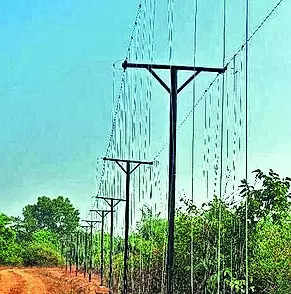Bhubaneswar: For the first time in the state, a hanging solar fence, which produces 4-5 volts of non-lethal current on touching it, has been installed in a 1.1-km stretch of Chandaka Wildlife Sanctuary, located on the city outskirts, to prevent elephants from straying into human habitation.
Elephants pass frequently through the stretch which is near slums and residential areas.
“The fence, around 15-ft high, releases DC current for one-fourth of a second upon touching it. This has proved to be most effective as we have seen elephants returning to the forest after touching the dangling aluminium wires charged with solar (DC) current,” said Susanta Nanda, principal chief conservator of forests, wildlife.
Sarat Behera, divisional forest officer (Chandaka), said a control panel has been set up nearby, which is manned by forest personnel.
“When required, we disconnect power to the fence. The solar fence can also check ungulates from straying into human habitation. Chandaka is surrounded by slums and residential areas along certain stretches. We have left around 3-ft space towards the bottom of the fence so that when grass, shrubs and bushes grow, they don’t create earthing,” he said.
Authorities of the sanctuary have planned to install more hanging fences to completely curb human-elephant conflict. Quite frequently, elephants from Chandaka stray into nearby residential areas triggering panic among residents. The forest personnel face a tough time to drive them back.
Earlier solar fences were being erected on ground, which were being damaged by people and animals. There have been instances in the past of solar fences put up to prevent straying of elephants getting defunct and poachers using them as traps to kill wild boar.
“They (villagers) draw power from a nearby electric pole and connect it to the fence. Humans have also been electrocuted by this practice. All defunct ground solar fences should be replaced by hanging fences,” said Biswajit Mohanty, secretary, Wildlife Society of Odisha, an NGO.
Elephants pass frequently through the stretch which is near slums and residential areas.
“The fence, around 15-ft high, releases DC current for one-fourth of a second upon touching it. This has proved to be most effective as we have seen elephants returning to the forest after touching the dangling aluminium wires charged with solar (DC) current,” said Susanta Nanda, principal chief conservator of forests, wildlife.
Sarat Behera, divisional forest officer (Chandaka), said a control panel has been set up nearby, which is manned by forest personnel.
“When required, we disconnect power to the fence. The solar fence can also check ungulates from straying into human habitation. Chandaka is surrounded by slums and residential areas along certain stretches. We have left around 3-ft space towards the bottom of the fence so that when grass, shrubs and bushes grow, they don’t create earthing,” he said.
Authorities of the sanctuary have planned to install more hanging fences to completely curb human-elephant conflict. Quite frequently, elephants from Chandaka stray into nearby residential areas triggering panic among residents. The forest personnel face a tough time to drive them back.
Earlier solar fences were being erected on ground, which were being damaged by people and animals. There have been instances in the past of solar fences put up to prevent straying of elephants getting defunct and poachers using them as traps to kill wild boar.
“They (villagers) draw power from a nearby electric pole and connect it to the fence. Humans have also been electrocuted by this practice. All defunct ground solar fences should be replaced by hanging fences,” said Biswajit Mohanty, secretary, Wildlife Society of Odisha, an NGO.
